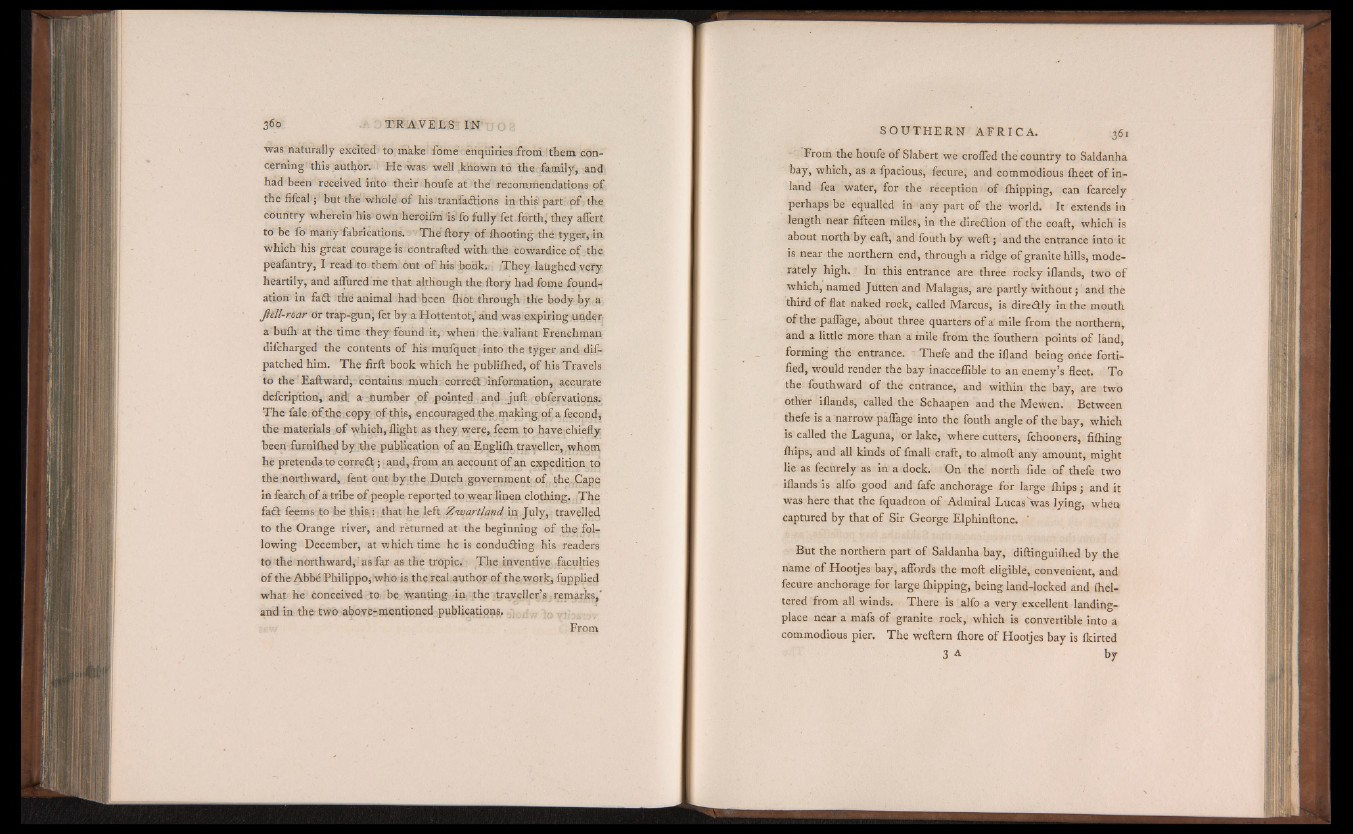
was naturally exfcited to make fome enquiries from them concerning
this author. He was. well known to the family, and
had been received into their houfe at the recommendations of
the fifcal jbbut the whole of his tranfaâions in this'parti of; the
country wherein his Own heroifm is'fo fully fet forth, they affert
to be io many'fabrications. - The ftory of ihooting -the tyger, in
which his great courage is contrafted with the cowardice o f the
peafantry, I read sto them out of his bobkv T h e y laughed very
heartily, and affuréd me that although the ftory had fome foundation
in fa£t the animal had been ihot through the body by a
Jiell-roar 6r trap-gun, let by a Hottentot, and was expiring under
a buih at the time they found it, when the valiant Frenchman
difcharged the contents of his mufquet into the tyger and dispatched
him. The firft book which he publifhed, of his Travels
to the Eaftward, contains much correi! information, accurate
defcription, and a number of pointed and juft obfervations.
The fale of the copy of this, encouraged the making of a fccond,
the materials , of which, flight as they were, feem to have chiefly
been furniihed by the publication of an Englilli traveller, whom
hé pretends to corredi ; and, from an account o f an expedition to
the northward, fent out by the Dutch government of the Cape
in fearch o f a tribe o f people reported to wear linen clothing. The
fail feems to be this. : that he left Zuoartland in July, travelled
to the Orange river, and returned at the beginning of the following
December, at which time he is conducting his readers
to the northward, as'far as the tropic.: The inventive faculties
of the Abbé Philippo* who is the real author of the, work, fupplied
what he conceived tor be. wanting-in; . the traveller’s remarks,'
and in the two above-mentioned publiGatipns.
From
From the houfe of Slabert we croffed the country to Saldanha
bay, which, as a fpacious, fecure, and commodious iheet of inland
fea water, for the reception of ihipping, can fcarcely
perhaps be equalled in any part of the world. It extends in
length near fifteen miles, in the direction of the coaft, which is
about north by eaft, and fouth by weft ; and the entrance into it
is near the northern end, through a ridge of granite hills, moderately
high. In this entrance are three rocky iflands, two of
which, named Jutten and Malagas, are partly without; and the
third o f flat naked rock, called Marcus, is direitly in the mouth
of the pafiage, about three quarters of a mile from the northern,
and a little more than a mile from the fouthern points of land,
forming the entrance. Thefe and the ifland being once fortified,
would render the bay inacceflible to an enemy’s fleet. To
the fouthward o f the entrance, and within the bay, are two
other iflands, called the Schaapen and the Mewen. Between
thefe is a narrow pafiage into the fouth angle o f the bay, which
is called the Laguna, or lake, where cutters, fchooners, fiihing
ihips, and all kinds of fmall craft, to almoft any amount, might
lie as fecurely as in a dock. On the north fide of thefe two
iflands is alio good and iafe anchorage for large ihips; and it
was here that the iquadron of Admiral Lucas was lying, when
captured by that of Sir George Elphinftone. I
But the northern part of Saldanha bay, diftinguiihed by the
name of Hootjes bay, affords the moft eligible, convenient, and
fecure anchorage for large ihipping, being land-locked and ihel-
tered from all winds. There is alfo a very excellent landing-
place near a mafs of granite rock, which is convertible into a
commodious pier. The weftern ihore of Hootjes bay is ikirted
3 A by